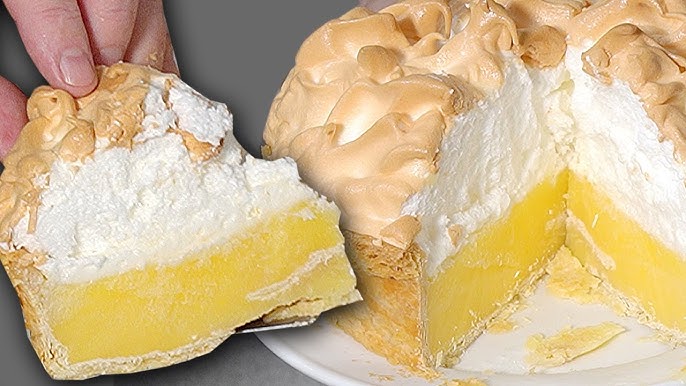Lemon and Meringue Pie Recipe: Lemon meringue pie is one of those desserts that feels like a warm hug from your grandmother. It’s the kind of recipe that’s been handed down through generations, filling kitchens with the sweet scent of lemon zest and the comforting crisp of golden meringue.
The origins of lemon meringue pie trace back to the 19th century, combining the tart brightness of lemon custard with the sweet, airy finish of meringue. Together, they create a perfect harmony of flavor and texture.
This pie has become a staple in diners, bakeries, and holiday tables—and for good reason. It looks impressive, tastes divine, and satisfies any sweet tooth craving with its zesty and creamy profile.
Why You’ll Love This Recipe
What makes this particular lemon meringue pie recipe stand out? It’s approachable, reliable, and loaded with flavor. Whether you’re a first-timer or a seasoned baker, you’ll find that each step is straightforward and rewarding. The crust is buttery and flaky, the lemon filling is rich with citrusy zing, and the meringue? Light, fluffy, and slightly toasted for that extra “wow” factor. You won’t need any complicated equipment or rare ingredients—just some time, patience, and love for baking. Trust me, once you make this pie from scratch, store-bought versions will never taste the same again.
Ingredients You’ll Need
For the Pie Crust
Let’s start with the base of it all—the crust. You can use a pre-made crust if you’re short on time, but making your own is a game-changer.
Ingredients:
- 1 1/4 cups all-purpose flour
- 1/2 cup unsalted butter, chilled and cut into cubes
- 1/4 tsp salt
- 2-4 tbsp ice water
This basic pastry crust is tender and holds up beautifully against the filling. You want it firm but not tough—perfectly flaky without falling apart.
For the Lemon Filling
The star of the show! That sweet-tart lemony goodness is what makes this pie so addictive.
Ingredients:
- 1 cup granulated sugar
- 2 tbsp all-purpose flour
- 3 tbsp cornstarch
- 1/4 tsp salt
- 1 1/2 cups water
- 2 lemons, zested and juiced
- 2 tbsp unsalted butter
- 4 large egg yolks, lightly beaten
The combo of cornstarch and flour thickens the filling beautifully, while lemon juice and zest add that zingy brightness we crave.
For the Meringue Topping
The crown jewel—pillowy meringue with that signature golden-brown finish.
Ingredients:
- 4 large egg whites
- 6 tbsp granulated sugar
- 1/4 tsp cream of tartar
- 1/2 tsp vanilla extract (optional)
Whipping the whites with sugar creates that glossy, cloud-like texture that browns so nicely in the oven.
Step-by-Step Instructions
Step 1: Preparing the Pie Crust
First things first, let’s get that crust ready. In a large bowl, mix the flour and salt, then cut in the chilled butter using a pastry cutter or your fingers until the mixture resembles coarse crumbs. Gradually add ice water, one tablespoon at a time, just until the dough starts to come together. Avoid overworking it—just enough to bring it into a ball.
Wrap the dough in plastic wrap and chill in the fridge for about 30 minutes. Once it’s firm, roll it out on a lightly floured surface to fit a 9-inch pie dish. Press it in gently, trim the edges, and prick the bottom with a fork. Bake the crust at 375°F (190°C) for 12–15 minutes, or until it just starts to brown. Let it cool while you prep the filling.
Step 2: Making the Tangy Lemon Filling
Now for that luscious lemon layer. In a medium saucepan, whisk together the sugar, flour, cornstarch, and salt. Gradually stir in the water, lemon juice, and lemon zest. Bring it to a boil over medium-high heat, stirring constantly until it thickens and bubbles.
Once thickened, reduce the heat. Add a few spoonfuls of the hot mixture to your beaten egg yolks to temper them—this step is crucial to prevent scrambled eggs! Slowly whisk the yolks into the pot. Cook for another 2 minutes, stirring constantly. Remove from heat and stir in the butter until melted. Pour the warm filling into your prepared crust and smooth the top.
Step 3: Whipping Up the Meringue
This is where things get fluffy! Meringue might seem intimidating, but with the right technique, it’s actually quite simple. First, make sure your mixing bowl is clean and dry—any grease or moisture can ruin your meringue. Using an electric mixer, beat the egg whites on medium speed until they become frothy.
Add the cream of tartar, which helps stabilize the meringue, and continue beating. Slowly sprinkle in the sugar, a tablespoon at a time. Patience pays off here—adding the sugar too quickly can deflate your whites. Beat until stiff, glossy peaks form. If you lift the beaters and the meringue stands up like a proud peak, you’ve nailed it. For a touch of extra flavor, fold in a splash of vanilla extract.
Step 4: Assembling the Pie
With your crust baked, lemon filling hot, and meringue whipped to perfection, it’s time to build your masterpiece. Spoon the meringue over the warm lemon filling immediately—this helps seal the meringue to the filling and prevents separation.
Start by spreading meringue around the edge first to anchor it to the crust, then work your way toward the center. Use the back of your spoon to make decorative swirls and peaks. The more dramatic, the better—they’ll toast beautifully in the oven.
Step 5: Baking to Perfection
Pop the pie back into the oven at 350°F (175°C) for about 10–15 minutes, or until the meringue is lightly golden brown. Watch it closely—meringue can go from toasty to torched in seconds!
Once out of the oven, let the pie cool completely on a wire rack. Then refrigerate for at least 3–4 hours to allow the filling to set. Don’t slice too soon or the filling might ooze out. It’s worth the wait, I promise.
Serving and Storing Tips
How to Serve for Best Flavor
Lemon meringue pie is best served chilled. The contrast between the tangy lemon layer and the sweet, airy meringue is most enjoyable when the pie is cold and firm. Use a clean, sharp knife dipped in hot water to make clean slices—this trick helps you get that perfect presentation.
Pair your pie with a hot cup of tea or coffee, or even a glass of sparkling water with lemon slices for a refreshing touch. It’s an ideal dessert for brunch, afternoon tea, or a summer dinner party.
Proper Storage and Shelf Life
If you have leftovers (and that’s a big if), store your pie loosely covered in the refrigerator. It’s best eaten within 2–3 days to enjoy the best texture and flavor. Avoid storing it uncovered as meringue tends to absorb fridge odors and moisture, which can make it weep or collapse.
Never freeze lemon meringue pie—the meringue doesn’t hold up well to freezing and thawing. If you need to make it ahead, consider preparing the crust and filling a day early, then adding the meringue and baking it fresh the next day.
Tips for Perfect Lemon Meringue Pie
Preventing a Soggy Crust
One of the most common pie pitfalls is a soggy bottom crust. Nobody wants a wet, mushy base under their luscious filling. Here’s how to avoid it: blind-bake your crust. That means baking the crust on its own before adding the filling. Prick the bottom with a fork, line it with parchment paper, and fill it with pie weights or dried beans to keep it from puffing up. Bake until golden and crisp.
Another helpful tip? Brush the inside of the crust with a beaten egg white just before adding the lemon filling. This forms a seal and helps repel moisture, keeping the crust crisp even after the pie is chilled. It’s a small step that makes a big difference.
Stabilizing the Meringue
Floppy or shrinking meringue can be a downer. To prevent this, make sure your meringue fully covers the hot lemon filling—no gaps! That direct contact helps the meringue cook evenly and reduces the chance of separation.
Also, add the sugar slowly while whipping the egg whites. Rushing this process can cause graininess or unstable peaks. Using cream of tartar is another pro move—it stabilizes the egg whites and helps them hold their shape longer. Some bakers even dissolve cornstarch in a bit of water and fold it into the meringue as an extra safeguard.
Lastly, always bake the meringue until it’s fully set and lightly browned. Undercooked meringue can collapse or weep liquid after cooling, which isn’t pretty or tasty.
Common Mistakes to Avoid
Even experienced bakers can slip up, but here are the most frequent issues and how to dodge them:
- Not tempering the eggs: Adding hot lemon mix directly to egg yolks can scramble them. Always temper slowly to avoid curdling.
- Skipping blind baking: If you pour filling into an unbaked crust, you’re almost guaranteed a soggy pie.
- Underwhipping or overwhipping meringue: It should be stiff and glossy. Underwhipped and it’ll collapse. Overwhipped and it’ll dry out.
- Not sealing meringue to crust: Air pockets can form, causing the meringue to shrink or slide off.
- Cutting too soon: Chill that pie! Give it time to set or you’ll end up with a runny mess.
Paying attention to these small details will turn your good pie into a great one, every single time.
FAQs about Lemon and Meringue Pie Recipe
Can I use bottled lemon juice?
Fresh lemon juice is best for bright, zesty flavor, but in a pinch, bottled juice can work. Just note that the taste might be a bit duller or slightly bitter.
Why did my meringue shrink?
Meringue often shrinks because it wasn’t spread to the crust edge or wasn’t baked long enough. Make sure the meringue touches the crust all around and bake until it’s set.
How long does lemon meringue pie last?
It stays fresh in the fridge for about 2–3 days. After that, the crust softens and the meringue may start to weep.
Can I make it ahead of time?
You can prepare the crust and lemon filling a day ahead, but add and bake the meringue the day you plan to serve it for the best texture.
What can I substitute for cornstarch?
Arrowroot powder or tapioca starch are good substitutes, but cornstarch offers the most stable consistency for the lemon filling.
Conclusion
Lemon meringue pie is more than just a dessert—it’s a celebration of flavor and texture that’s been cherished across generations. From the flaky crust to the vibrant lemon filling and cloud-like meringue, every bite is pure joy. And the best part? You don’t need to be a pastry chef to pull it off. With a little patience and these step-by-step instructions, you can master this classic treat and impress family and friends alike. So roll up your sleeves, zest those lemons, and let your kitchen fill with the sweet scent of success.



